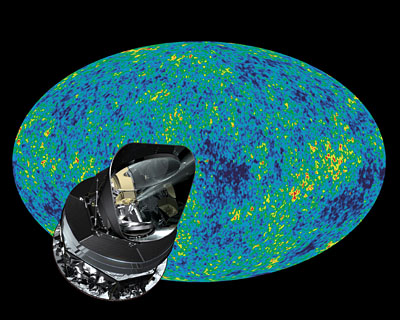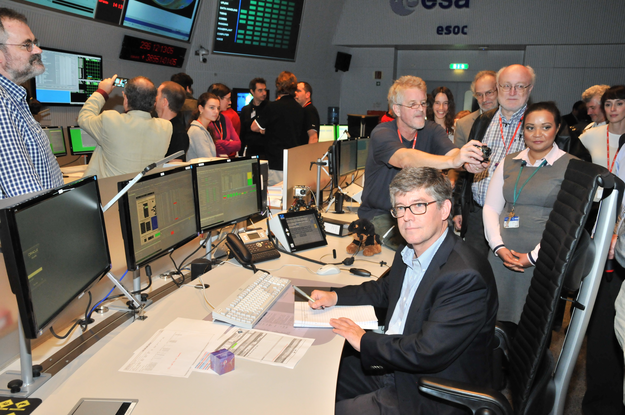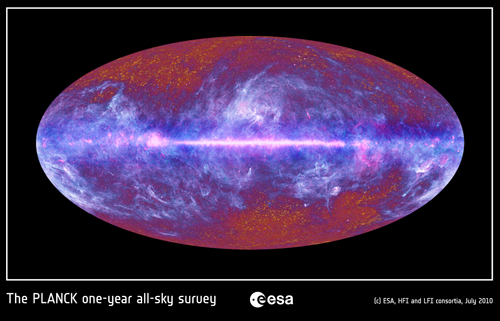
Europe’s Planck satellite has been turned off after nearly 4.5 years of soaking up the relic radiation from the Big Bang and studying the formation of stars and galaxies throughout fourteen billion years of cosmic history.
Since its launch in 2009, Planck has been mapping the entire sky to observe the afterglow of the Big Bang – the Cosmic Microwave Background. This relic radiation reveals the Universe as it was 380,000 years after it began, and contains clues about the first moments of the cosmos.
Dr Chris Castelli, Acting Director of Science, Technology and Exploration at the UK Space Agency, said, “We’re immensely proud to have played a key role in this amazing discovery machine. With its ability to make such detailed and accurate observations, Planck has found some of the missing pieces of a jigsaw that will eventually reveal a full picture of the evolution of our Universe.”
The final command to the satellite was sent this afternoon by mission controllers at the European Space Agency’s operations centre in Darmstadt, Germany. The instruments and cooling systems were turned off a few days ago, and the final instructions sent today asked the satellite to use up the last bit of fuel on board and turn off its transmitter.
The mission began drawing to a close in August, when the satellite was nudged away from its operational orbit around the Sun–Earth ‘Lagrange 2’ point towards a more distant long-term stable parking orbit around the Sun.

Planck and its two instruments operated successfully in space for over four years, scanning the sky at nine different colours of microwave light.
While Planck operated successfully in space for over four years, the full history of the mission is much longer. Since its conception, UK scientists have played a key role in the mission, working with colleagues from the rest of Europe and around the world.
“Those of us who built the hardware for Planck have been working on the mission for the best part of 20 years,” comments Prof. Richard Davis OBE, University of Manchester, who led the UK’s involvement in Planck’s Low Frequency Instrument (LFI). “It is a tribute to ESA and the many countries and even continents that have contributed to this successful project.” he continues.
“We started designing the High Frequency Instrument (HFI) in 1992 with our French and US colleagues, and produced the cryogenic detectors cooled to 0.1 degrees above absolute zero to provide it with exquisite sensitivity,” says Prof. Peter Ade, of Cardiff University. “The Planck satellite fulfilled its task in providing cosmologists with a reference set of ‘text book’ data on the state of the early Universe, which are proving to be an invaluable resource for other astronomers.”
Planck’s innovative cooler, reaching -273.05 Celsius, prevented the cosmic signals from being swamped by the heat from the satellite itself, allowing Planck to distinguish temperatures of a few millionths of a degree in the Cosmic Microwave Background. By scanning narrow strips around the sky over six months per survey, Planck was able make a complete sky map.
The original target was to complete two full surveys but the mission managed to make five full surveys with both instruments before HFI’s helium coolant was exhausted in January 2012.
“Planck continued using LFI right up until last week, exceeding all expectations and providing us with bountiful data to work with in the future,” says Jan Tauber, ESA’s Planck project scientist.
As well as insights about the origins of structure in the Universe, Planck has provided exquisite views of material in the foreground. From the formation of stars in our galaxy, to catalogues of previously unknown clusters of distant galaxies, such material is a treasure trove for astronomers everywhere.
“Planck’s real power is that it allows us to separate the light from our galaxy and all the other intervening matter from the glow of the CMB,” explains Prof Andrew Jaffe, Imperial College London. “It is this map of the early Universe which allows us to uncover the secrets of the cosmos.”
The first maps of the CMB were released earlier this year, based on just some of the Planck data, and refined the measurements of the age and composition of the Universe as well as revealing clues about the first moments of the Universe’s existence.
“Planck has given us a fresh look at the matter that makes up our Universe and how it evolved, but we are still working hard to further constrain our understanding of how the Universe expanded from the infinitely small to the extraordinarily large, details which we hope to share next year,” concludes Dr Tauber.
For more information, see the ESA Planck website.
